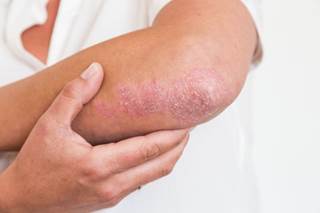
The recommendation to use TNFi biologics in treatment-naive patients with PsA will represent a major change in practice for many rheumatologists. Photo Credit: Hercules Robinson
A new guideline jointly issued by the American College of Rheumatology and the National Psoriasis Foundation (ACR/NPF) on the treatment of psoriatic arthritis (PsA) includes a conditional recommendation to use tumor necrosis factor inhibitor (TNFi) biologics over oral small molecule drugs as first-line therapy in patients with active disease.1 The guideline provides evidence-based pharmacologic and nonpharmacologic recommendations on the management of treatment-naive patients with active PsA and patients who have active PsA despite therapy, with a focus on long-term treatment. The intended audience for the guideline includes both clinicians and patients at risk for or with PsA.
Dafna Gladman, MD, FRCPC, rheumatology professor of medicine at the University of Toronto and member of the NPF Medical Board who served as a content expert on the guideline’s core team, told Rheumatology Advisor that the recommendation to use TNFi biologics in treatment-naive patients with PsA will represent a major change in practice for many rheumatologists. “Most other recommendations identify methotrexate as the first line [treatment], followed by biologic agents,” she noted. “GRAPPA [Group for Research and Assessment of Psoriasis and Psoriatic Arthritis] recommendations suggest moving to biologic agents immediately if there are bad prognostic signs.”
The recommendation to use biologics as first-line treatment also diverges from recommendations by the European League for Rheumatism (EULAR) for PsA. EULAR recommends oral small molecule drugs as first-line agents for treatment-naive patients as the preferred therapy over biologics. EULAR’s recommendation was in part because of the lower cost of conventional oral small molecule agents, a consideration that the ACR/NPF panel ranked lower than the quality of evidence pointing to the benefit of TNFi biologics.1,2
Another key recommendation in the ACR/NPF guideline is a conditional recommendation to use a treat-to-target strategy for all patients with active PsA. Treating to target involves the regular assessment of disease activity using objective outcome measures. Based on the results of these measures, treatments are adjusted until predefined therapeutic targets are achieved. The ACR/NPF guideline does not stipulate a particular target, but suggests that minimal disease activity or Disease Activity of Psoriatic Arthritis low disease activity or remission criteria be used.
“Treat-to-target is key, because it encompasses all clinical scenarios, rather than one particular clinical situation,” stated Jasvinder Singh, MD, MPH, a rheumatologist at University of Alabama at Birmingham and principal investigator for the guideline project, in a press release accompanying the guideline’s release.3 “The available evidence suggests the irreversible joint damage, associated functional limitations, joint deformities, and disability associated with PsA could possibly be avoided/delayed with optimal disease management using a targeted approach. A targeted approach can also improve pain, function, and quality of life and social participation.”
The ACR/NPF guideline also provides recommendations regarding the use of drugs in the context of comorbidities such as inflammatory bowel disease, diabetes, and serious infections; what to do with vaccinations; and recommendations for smoking cessation, exercise, physical therapy, and occupational therapy.
The guideline was created using the Grading of Recommendations Assessment, Development and Evaluation (GRADE) system. In addition to an assessment of the benefits and harms of the treatment options under consideration and the quality of evidence, the GRADE methodology takes into consideration the values and preferences of patients. An expert panel, including patients, patient advocates, rheumatologists, dermatologists, and a rheumatologist nurse practitioner determined the consensus and strength of the recommendations. A panel of 9 patients with PsA, most of whom had received biologic therapy, reviewed the evidence and provided input on recommendations, factoring in their own personal experience.
Because of limited data in some areas, the quality of evidence in the guideline was often graded low or very low. This led to 94% of recommendations being designated as “conditional,” with the remaining 6% designated as “strong.” Conditional recommendations apply to the majority of patients but may not be appropriate for all, necessitating a shared decision-making approach. Strong recommendations apply to all or nearly all patients.
The strong recommendations in the guideline include 3 that apply to adult patients with active PsA and concomitant active inflammatory bowel disease (an extra-articular manifestation of PsA) despite treatment with an oral small molecule drug such as methotrexate:
- Switch to a TNFi monoclonal antibody biologic over switching to a TNFi biologic soluble receptor biologic
- Switch to a TNFi monoclonal antibody biologic over switching to an interleukin (IL)-17i biologic
- Switch to an IL-12/IL-23i biologic over switching to an IL-17i biologic
The other strong recommendations in the guideline are:
- In adult patients with active PsA and frequent serious infections who are naive to oral small molecule and biologic drugs, start an oral small molecule drug over a TNFi biologic.
- In adult patients with active PsA, recommend smoking cessation over no smoking cessation.
Dr Gladman cautioned that the guideline does not cover all the complexities of PsA. “Further recommendations will need to be developed for other features not covered here, axial disease as an example. Moreover, the major limitation of all the guidelines and recommendations is the fact that we do not have comparative studies of the various drugs currently available. Research will concentrate on doing such studies, as well as understanding the pathogenesis, or mechanism of disease, better, so that additional target for therapeutic intervention could be developed. Moreover, we aim to develop an even better personalized approach based on clinical and biomarker information.”
References
- Singh JA, Guyatt G, Ogdie A, et al. 2018 American College of Rheumatology/National Psoriasis Foundation Guideline for the Treatment of Psoriatic Arthritis [published online November 30, 2018]. Arthritis Rheumatol. doi: 10.1002/art.40726
- Gossec L, Smolen JS, Ramiro S, et al. European League Against Rheumatism (EULAR) recommendations for the management of psoriatic arthritis with pharmacological therapies: 2015 update. Ann Rheum Dis. 2016;75(3):499-510.
- National Rheumatology and Psoriasis Organizations Release Joint Guideline for Treating Psoriatic Arthritis [press release]. Atlanta, Georgia: American College of Rheumatology. https://www.rheumatology.org/About-Us/Newsroom/Press-Releases/ID/986. Published December 4, 2018. Accessed December 4, 2018.








